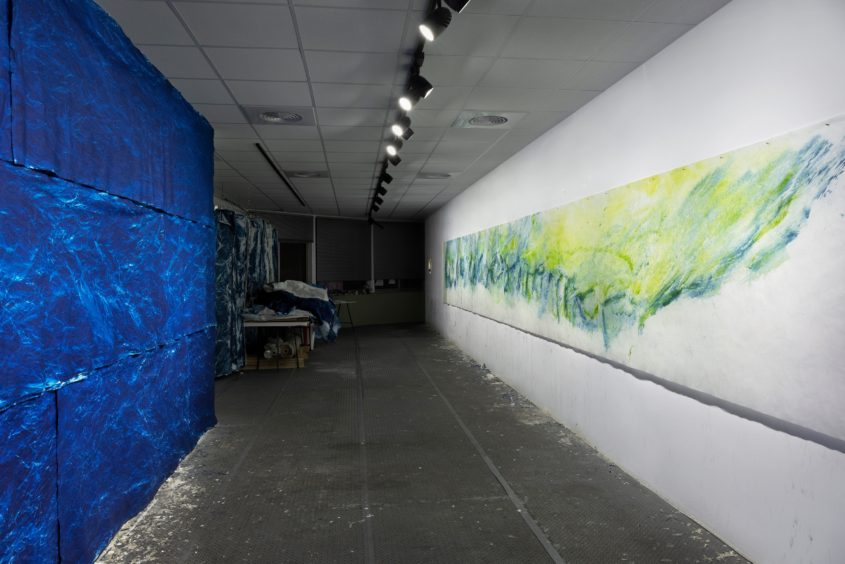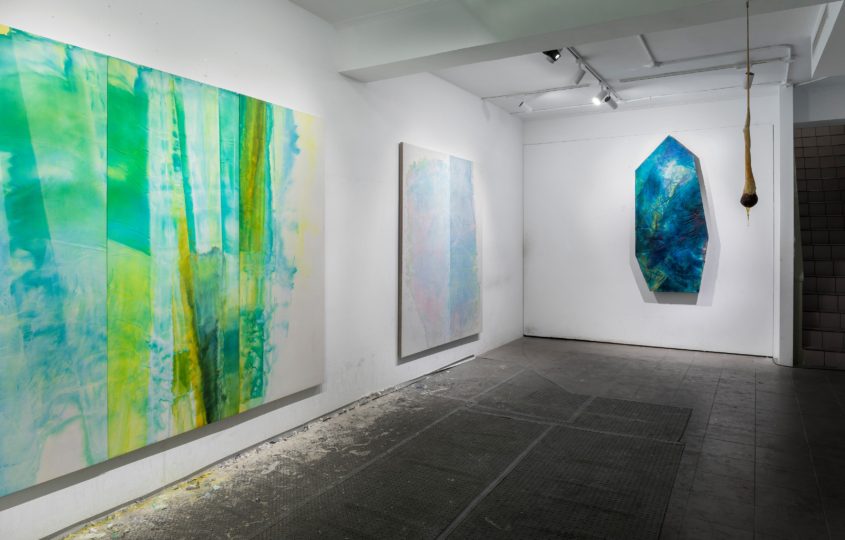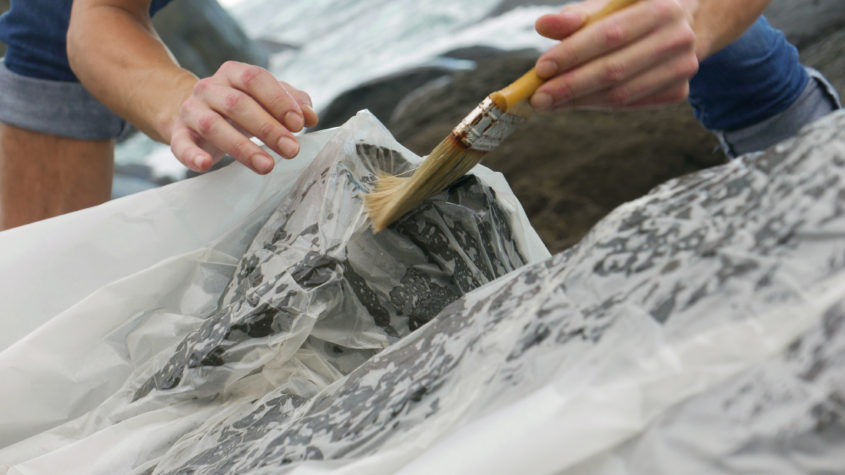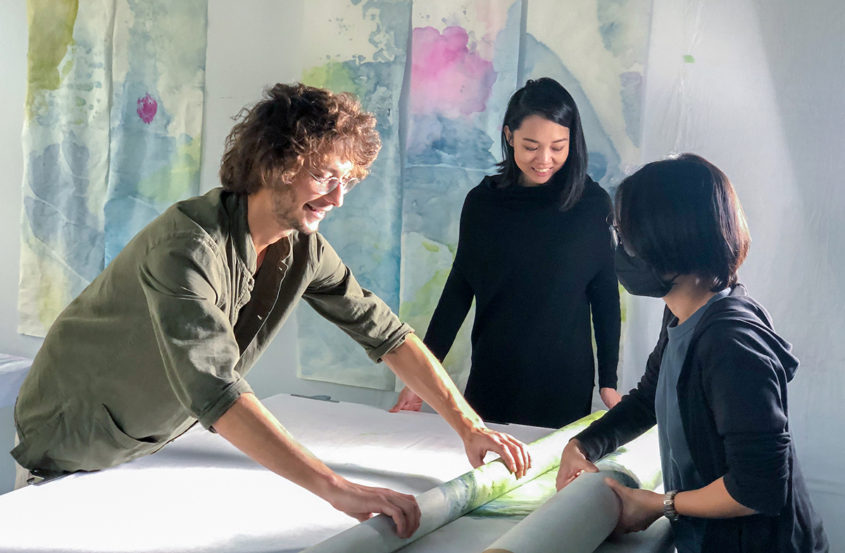Wu Chi-Tsung x Saverio Tonoli
We both found our inspirations from the other side of the world

Installation view of “Beyond the Now, Away from Here” in Wu Chi-Tsung Studio
T= Saverio Tonoli W = Wu Chi-Tsung
How did you know each other?
T: We met in an opening studio event, 2017 in Künstlerhaus Bethanien, Berlin, Germany. Walking through the studios, Chi-Tsung’s work caught my eye immediately as I was looking for someone who also uses Xuan paper like I do. Paper became our main topic for the rest of the night. The rest came spontaneously: we kept in touch, visited each other’s studio and did a project in Berlin together. We already had the idea of this residency program since 2018, and finally managed to execute it now.
W: From the very beginning, we were talking about Xuan paper. Every time I visit Saverio, I always bring a different kind of Xuan paper for him to test the material, and eventually I came up with the idea to invite him to Taiwan so that he could have a period of time to research more about Xuan paper.
I learned that the title of this exhibition ‘Beyond the Now, Away from Here’ comes up from your discussion. How would you two interpret it?
T: Both of us revisit traditional techniques in our art practice. Other than works on paper, I developed a variation of the Fresco – mural painting, making it more simple to paint and install and at the same time to enhance its freedom of movement. This gave us the input to to transform the studio space through our artworks and question the “here and now”, working on time and space.
W: We hope to present a detached experience to the audiences that merge the culture of Europe and Asia, and art practices of classic and contemporary. Our idea is to combine all the things to have a new dialogue.
(To Chi-Tsung) Is this the first time you open your studio to the public for an exhibition?
W: We would like to take the opportunity of the Taipei Dangdai Art Fair that brings international audiences and professionals to Taiwan. This year, we want to do something new in our studio and host a party here in order to directly meet people. Moreover, I hope that we could show the possibilities of what artist studios could do and how exhibitions could be to the Taiwanese art world. At the moment, most artwork you see in Taiwan are completed and displayed in white cubes and visiting artist studios is always considered to be private. However, I think that art is about the whole thing and can’t be concluded by the final “art piece” only. We want to open our studio to let everyone see the art practice. This time, we will divide the studio into different functions on different floors during the exhibition, and make this space like an alternative space with abundant content. It would give people a special experience of the art-making.
(To Chi-Tsung) How do you consider the role and possibility of an artist studio in the art world?
W: To host an artist residency program as an artist studio ourselves this time, I am inspired by my residency experience in MoT+++, Vietnam, the director of which herself is also an artist. At that time, we turned the exhibition space into a studio-like environment, and the exhibition was more like an open studio. It was a very interesting concept and I received many positive feedbacks.
The position of artist studios has changed a lot in a few decades. Nowadays you see more and more artist studios getting bigger with multi-functions. It is not only a space for simply producing art, but a center to form the networks in the art world. Compared with institutions, the artist studio could gain more independence and flexibility in communications and executions. Besides, we are proud that we are financially independent so as to make things happen. Hopefully our experience could inspire other people and contribute to the diversity of the Taiwanese art world.
(To Saverio) We saw on your Instagram that you’re working on new works for this exhibition. Are they inspired by your experience during the residency in Taiwan? If so, what are they?
T: Normally I enjoy working alone and consider the status of isolation essential for me. Finding materials and new providers, joining a talkative unknown group of artists, having to limit your working space and adhere to inevitable social conventions makes it challenging to recreate the proper working conditions. But this one is more of a private collaboration residency: I get a lot of support from the studio and plenty of isolation! Besides, Taiwan is beautiful free country with amazing landscapes and fruits.
Parallel my ongoing development on abstraction in painting, my work brought me here to study ink tradition and research on paper. With the expertise of FENKO Catalysis Chamber (www.fenko.com.tw) – one of the most important material lab in Taiwan producing paper – I can push to extreme ways some treatments on paper, with gravity and folds. I am looking forward to the exhibition to share my journey with international audiences.
(To Saverio) How was your cooperation with FENKO?
T: FENKO expands the use of paper in many different fields, one of which is the open collaboration with artists, and they research endlessly new materials and possibilities. FENKO’s expertise has been very precious to me, from consulting wide range of paper materials, packaging to paper preservation. Together we’ve found a perfectly suitable paper for one of my main works in the show, Self-absorbed on the rocks, painted on the cliffs of the Yilan coast of Taiwan. In this work, the large roll of paper is made wet and folded into the structure of the cliff, then ink-washed to extract its structure, volume and essence. At the last stage in the studio the paper is washed and flatten again. It is not hard to imagine that this specific work needs a very strong and flexible paper, due to the extreme treatment it undergoes on sharp rocks and having to be folded, washed and dried several times. The absorbing qualities of the paper is also very important. The paper has been designed for this purpose. My collaboration with FENKO will continue for three other pieces of the series, one of which will be performed in the following weeks on the south Vietnamese coast.
Saverio with Paper & Conservation Consultancy Szuhan Wang and director Lino Lee from FENKO Catalysis Chamber
Clearly both of you are experts on media and materials, and you both have interests in natural phenomena and daily objects. However, you reach art through the opposite route: Chi-Tsung learned painting first and get in touch with photography later in college; whereas Saverio grew up with photography and later experiment with painting and other media. How do you think about each other’s art? What would you say about the similarities and differences between your art?
T: Our attitude towards art is similar, nothing strictly political, social or personal but “beyond” and “away”. Everything in our art is about matter and perception. As we work with similar materials, we often discuss certain techniques and difficulties we encounter. For example, we both mount Xuan paper on canvas which differs from the tradition, so we always discuss how to mount and coat.
W: I think that the most interesting and fundamental part of both of us is that we are both painters, that is to say, our mentalities are both based on paintings. And we are both interested in water-based things. I use western techniques to express eastern sceneries, and Saverio is into eastern materials. We both found our inspiration from the other side of the world. I think this kind of connection is beautiful.
Nevertheless, the direction of how we approach art is different. I don’t do ‘painting painting’. My priority in art is media art, but I use painting as a mentality to meditate on everything while Saverio deals with painting itself.
T: Yes. My starting point was to work with my dad in the darkroom in our garage, where he showed me how the image is revealed. From then I started to substitute light with ink, with Italian materials, eastern materials etc. I always see the possibilities of painting in photography. When I work digitally on images with photoshop, I regard it as an alternative way of painting. )
I suppose it’s going to be the first exhibition you attend in 2020. Do you have any new year resolution on art, or to say, what would you like to explore more in the following year?
T: In this year, Inspired by my experience here I’m would like to open a second studio in Taipei, I’m working on it. After joining another residency in Saigon by A.Farm I will come back to Berlin in June and begin to understand what I have experienced in Asia during this months. Exploration will go on as usual.
W: It has been 20 years since I entered university in 1999. I started the studio three years ago and we have made amazing achievements. I have been focused on my art outside Taiwan and would love to be considered as an international artist rather than a Taiwanese artist. I wish this experience of working internationally with my studio could be a model to share with the art world in Taiwan in the near future. Moreover, I look forward to launch more collaboration programs and to make use of the resources we have in Taipei, Berlin and Saigon. We have much to share about our network and experience in these three cities.
Interviewed and translated by Wang Tianyi
Planning and Proofread by Julian Chu
吳季璁與薩維里奧・托諾利
我們都從世界的另一邊汲取靈感

《易時易地》於吳季璁工作室
薩=薩維里奧・托諾利, 吳=吳季璁
你們是如何認識對方的?
薩:我們在2007年德國貝塔寧藝術村的開放工作室活動中相識。當我走進活動場地時,季璁的作品一下子就從遠方牢牢吸引了我,因為我一直在找和我使用相同材料(宣紙)的人。那天我們的話題一直圍繞宣紙打轉。在這之後我們自然而然保持聯繫,相互拜訪對方的工作室、並且在柏林一起做了展覽項目。其實自2018年,我們就有了在季璁的台北工作室舉辦駐村項目的想法,但今年才得以實現。
吳:對,我們從一開始就一直在聊宣紙。每次我拜訪薩維里奧的時候,我都會給他帶上不同的宣紙讓他測試,並逐漸有了要邀請他來台灣的想法,這樣他就能有一段完整的時間研究材料。
聽說本次展覽的標題《易時易地》是你們共同討論的結果。你們如何詮釋這個標題呢?
薩:我和季璁都會去研究傳統媒材,並將他們運用在當代藝術實踐之中。除了使用宣紙創作之外,我也致力於探索濕壁畫的材料可能性,令其更為易於繪製與展示,同時增加其自由的流動感。這些(宣紙、溼壁畫)在藝術史中使用已久的材料是我們的靈感來源,也帶領我們置換工作室時空,反思何謂「此時此地」。
吳:我們希望融合歐洲與亞洲文化、古代與當代技法,為觀眾創造一個超然於此時此地的體驗。利用不同元素,開啟一個新的對話。
這是季璁第一次將工作室開放為面向公眾的展覽嗎?
吳:這次駐村項目正值台北當代藝術博覽會期間,許多國內外藝術界同仁與藏家、觀眾都會來台灣,我們藉此機會在工作室舉辦展覽和開幕Party,更直接地與大家交流,同時討論藝術家工作室與展覽的可能性,把我們的經驗和台灣的藝術圈分享。因為目前在台灣,絕大多數藝術作品均是以完成的狀態展覽在白盒子空間中,而參訪藝術家工作室則被視作是非常私人的行為。但是我卻認為藝術應是「一整件事」,不能只看到最終的作品,舉辦開放工作室展覽的目的也是為了讓每個人看到藝術創作的過程。我們將工作室空間分為不同功能,每一層都有不同的展示,讓工作室成為類似替代空間的場所,除了有豐富的內容外,也會給觀眾特殊的藝術體驗。
你如何看待藝術家工作室在藝術生態中的角色與可能性呢?
吳:這次想到以藝術家工作室舉辦駐村項目是啟發於我在越南MoT +++的駐村經驗,MoT+++的總監本人也是一位藝術家,當時我們嘗試將展覽空間變成了類似工作室的環境,呈現出的展覽更像是一個開放工作室。我認為這是很有趣的概念,並且收到了很多積極的反饋。
近幾十年來,藝術家工作室的角色發生了很大變化。如今,越來越多的藝術家工作室規模擴大,涉足的領域也更加多元。工作室不僅是一個單純用於生產藝術品的場地,而更是人際關係網的中心。與機構相比,藝術家工作室在交流和執行方面擁有更高的獨立性和靈活性。此外,我很開心我們的工作室能夠財務獨立,這是一切可能性的基礎。我希望我們的經驗可以啟發其他人,並為台灣藝術界的豐富性做出貢獻。
我們在薩維里奧的Instagram上看到你正在為新展覽創作新作品。這些作品是否與你此次在台灣駐村的經歷有關呢?
薩:一般來說我很享受獨自工作的狀態,獨處對我來說是極為重要的。在駐村過程中無論是尋找新的材料與供應商、結識新的藝術家朋友、適應有限的工作空間,以及適應地方文化都可能對藝術家的工作構成很大的挑戰。但是本次駐村經歷則更像一個私人的合作項目:吳季璁工作室為我提供了大量的支持,並且也令我能夠自由地獨自創作。此外,台灣是一个美麗而自由的國度,我沉迷於台灣的風景與紙墨文化。
也可以說是我的紙張作品將我帶來台灣。在這裡,我像海綿一樣學習和吸收關於傳統水墨的知識並潛心研究宣紙材料。在台灣最頂尖的紙張材質研究機構-FENKO鳳嬌催化室 (www.fenko.com.tw)(後文簡稱「鳳嬌」)的鼎力相助下,我找尋到了更有效的方法處理紙材,並且能夠更好地控制墨水在重力下的運動,我很期待在展覽中將我的探索分享給國際觀眾。
你是怎麼與鳳嬌合作的呢?
薩:鳳嬌在許多不同的領域開拓了紙張的用途,他們其中的一個嘗試便是與藝術家的合作,研究新的材料和可能性。本次,鳳嬌身為紙材顧問,為我在選紙、包裝和紙張保存方面提供了非常多寶貴的建議。我在鳳嬌的協助下,為這次展覽最主要的作品之一《Self-absorbed on the rocks》找到了理想的紙材,這幅作品是我將宣紙鋪佈在宜蘭海岸的峭壁上進行創作的。在岩壁上,我將大捲宣紙浸濕,將之按照岩壁的紋理折疊,再用墨水染色令岩壁的紋理、質感與量體在紙面顯現。最後,回到工作室後,宣紙被水洗並壓平。可想而知,這樣的處理工序對宣紙的強韌性與靈活性都有極高的要求,這樣才能受得了尖銳岩壁、多次折疊、浸濕與乾燥等極端技法。紙張的吸水性也非常重要,而這次使用的紙則完美滿足了上述要求。我還會在將來的三件作品中繼續與鳳嬌進行合作,其中一件我將在未來幾周內在越南南部海岸完成創作。

《Self-absorbed on the rocks》創作過程,使用鳳嬌的薄頁麻紙(ABA Lean Natural)
二位顯然都是媒體與媒材的專家,而且你們都鐘情於自然現象與日常物件。不過,你們接觸藝術的方式卻是相反的:季璁從小學習繪畫,後來在大學才接觸攝影,而薩維里奧卻從小接觸攝影,晚些才學習繪畫與其他媒材創作。你們怎麼評價彼此的藝術?你們認為你們之間的相同點與區別在哪裡?
薩:我們對待藝術的態度是相似的,我們的作品都沒有政治色彩,無關社會議題、個人經歷、環境或感覺,是「超越時間與地點而存在的」。另外,我們的作品使用相似的材料,我們經常會交流彼此的技術和遇到的困難。比如我們都用非傳統的方式將宣紙裝裱在畫布上,所以我們的話題常常圍繞在技術問題上。
吳:我認為我們最有趣的基礎共同點在於我們內在都是畫家,換句話說,我們都是以繪畫的方式和角度在思考。而且我們都對水的材料感興趣。我會使用西方的技法表現東方的意境,而薩維里奧也很熱衷於探索東方材料和文化,他甚至有在練習功夫。我們都從世界的另一邊汲取靈感,我認為這是非常美妙的連結。
然而,我們接觸藝術的方式是不同的。我主要做新媒體藝術,不用筆墨畫畫,但卻用繪畫的思維方式去思考所有的其他不同媒材。而薩維里奧則是專注處理繪畫本身。
薩:是的,我最早接觸藝術是和我父親一起在我家車庫的暗房中,在那裡,他向我展示了攝影的原理。從那時開始,我嘗試用墨水、義大利或東方的材料去模仿與替代光。當我用Photoshop處理圖片時,我認為我也只是在用數位的方式繪畫。
這想必是二位在2020年參加的第一個展覽。你們有什麼新年願望嗎?
薩: 這次的駐村經歷讓我想在台灣成立我的第二個工作室,我現在已經開始在為之做準備了。我會去越南胡志明市參與由A Farm主持的另外一個駐村項目,此後我會在6月回到柏林,花一段時間來總結一下我在亞洲的收穫。我的探索也會如昔繼續下去。
吳:現在距我1999年入大學已經20年了。三年前,我建立了工作室,至今我們已經有了些精彩的收穫和成績,在此期間我一直努力活躍於國際舞台,我期許自己被視為一位國際藝術家,而非僅是台灣藝術家。並希望未來能將我與工作室的國際化工作經歷能夠分享給台灣的藝術世界,啟發他人。另外,我也期待能夠進行更多的合作項目,妥善利用我們在台灣、柏林和越南的資源——在這三地我們都有太多能夠分享的事情與經驗了。
採訪、翻譯:王天藝
企劃、校對:朱莉安
